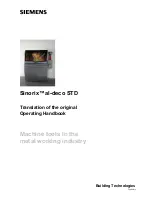
in a secure position with a firm grip and foot-
ing. Be aware that the sander can develop a
torque reaction. See the section “SAFETY PRE-
CAUTIONS”.
Use a clean lubricated air supply that will give
a measured air pressure at the tool of 90 PSI
when the tool is running with the lever fully
depressed. It is recommended to use an ap-
proved 10 mm (3/8”) x 8m (25ft) maximum
length airline. Do not connect the tool to the
airline system without an easily accessible air
shut off valve. It is strongly recommended that
an air filter, regulator and lubricator (FRL) be
used as this will supply clean, lubricated air at
the correct pressure to the tool. In any case ap-
propriate air pressure regulators shall be used
at all times while operating this tool where the
supply pressure exceeds the marked maximum
of the tool.
Details of such equipment can be obtained for
your tool distributor. If such equipment is not
used, the tool should be manually lubricated.
To manually lubricate the tool, disconnect the
airline and put 2 to 3 drops of suitable pneu-
matic motor lubricating oil into the hose end
(inlet) of the tool. Reconnect tool to the air
supply and run tool slowly for a few seconds to
allow air to circulate the oil. If the tool is used
frequently, lubricate it on a daily basis or lubri-
cate it if the tool starts to slow or lose power.
It is recommended that the air pressure at the
tool be 90 PSI while the tool is running so the
maximum RPM is not exceeded. The tool can
be run at lower pressures but should never be
run higher than 90 PSI. If run at lower pressure
the performance of the tool is reduced.
SAFETY PRECAUTIONS
1. Read all instructions before using this tool.
All operators must be fully trained in its use
and aware of these safety rules.
2. Make sure the tool is disconnected from the
air supply. Select a suitable abrasive and secure
it to sander.
3. Always wear required safety equipment
when using this tool.
4. When sanding, always start the tool on the
workpiece. This will prevent gouging due to
excess speed of the abrasive. Stop air flow to
the tool as it is removed from the workpiece.
5. Always remove the air supply to the sander
before fitting, adjusting or removing the abra-
sive or back-up pad.
6. Always adopt a firm footing and grip and
be aware of torque reaction developed by the
sander.
7. Always ensure the material being sanded is
firmly fixed to avoid movement.
8. Check hose and fittings regularly for wear.
Do not carry the tool by its hose; always be
careful to prevent the tool from being started
when carrying the tool with the air supply con-
nected.
9. Do not exceed maximum recommended
air pressure. Use safety equipment as recom-
mended.
10. Prior to installing any sanding or polishing
accessory, always check that it’s marked maxi-
mum operating speed is equal or higher than
the rated speed of this tool.
11. The tool is not electrically insulated. Do not
use where there is a possibility of contact with
live electricity, gas pipes, and/or water pipes.
12. Keep hands clear of the operation.
13. If the tool appears to malfunction, remove
from use immediately and arrange for service
and repair.
14. Do not allow the tool to operate without
taking precautions to protect any persons or
objects from the loss of the abrasive or pad
ruptures.
15. Immediately release the start handle in the
event of any disruption of pressure; do not at-
tempt to re-start until the disruption has been
corrected.
INSTALLING THE SANDPAPER
· Position the sander with its pad side facing
upward.
· Place the sandpaper on the pad so that the
center of the sandpaper is aligned with the
center of the pad and bend both ends of the
sanding paper at 90˚ angle. Then bend both
ends again as to cover the sander base.
· Insert one of the sandpaper ends and secure it
with the clamp, next insert the remaining bent
senction in the same way.
CAUTION: The sandpaper must be precisely
installed on the pad, ensuring that there is am-
ple tension. Loosely installed sandpaper could
6
UP766 manual.indd 6
10/06/15 9:32


























